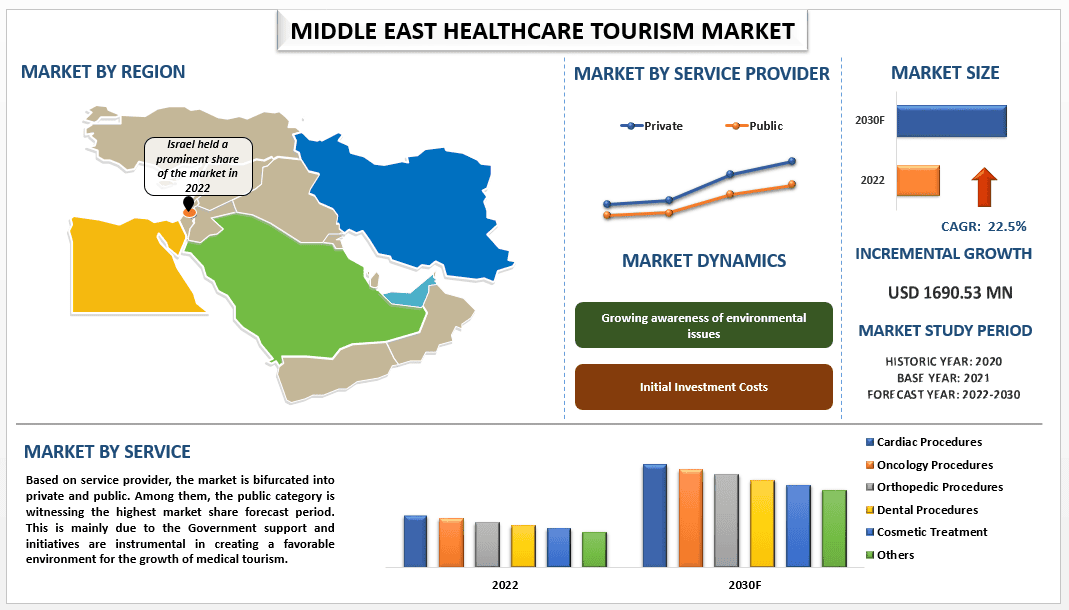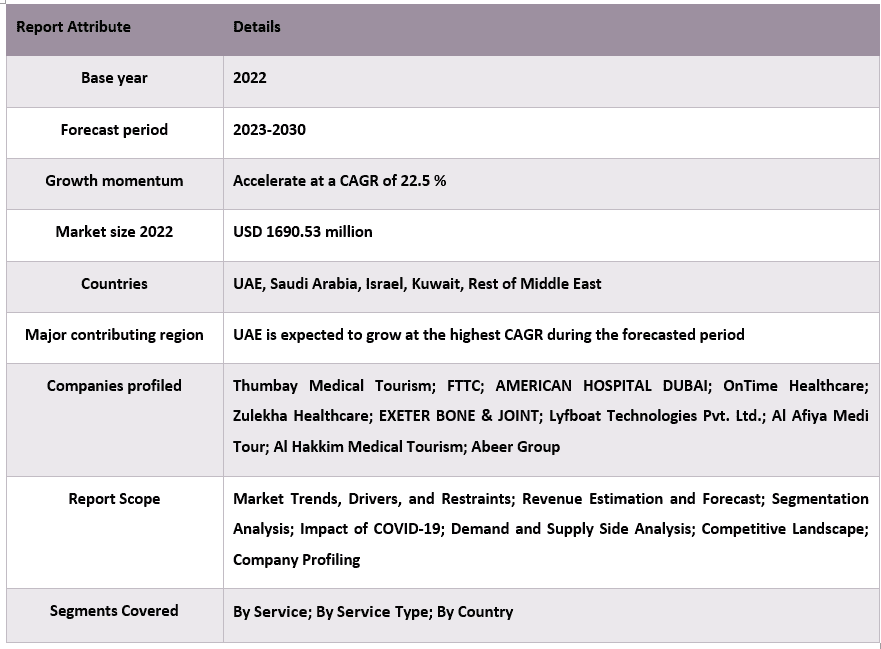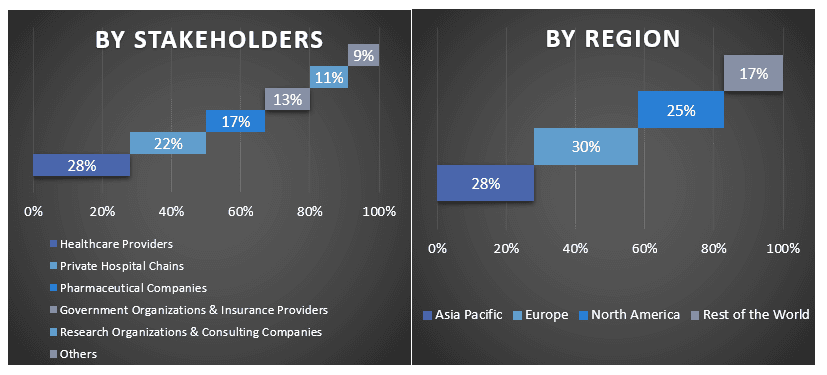중동 의료 관광 시장: 현재 분석 및 예측 (2023-2030)
서비스 강조 (심장 시술, 종양 시술, 정형외과 시술, 치과 시술, 미용 시술 및 기타); 서비스 제공자 (민간 및 공공); 국가.

중동 헬스케어 관광 시장은 2022년에 16억 9,053만 달러로 평가되었으며 예측 기간 동안 약 22.5%의 강력한 연평균 성장률(CAGR)로 성장할 것으로 예상됩니다. 이는 주로 걸프협력회의(GCC) 국가의 민간 의료 지출 증가가 핵심 동인으로 작용하여 세계적 수준의 의료 시설과 전문 서비스 개발을 가능하게 하기 때문입니다. 예를 들어, KSA의 의료 서비스 수요가 계속 증가하고 있으며, 이는 최근 몇 년 동안 이루어진 의료 서비스 지출 계획 및 의료 투자 증가로 확인되었습니다. Trade.gov에 따르면 KSA는 걸프협력회의(GCC) 국가 의료 지출의 60%를 차지하며, 해당 지역은 KSA 정부의 최우선 과제로 남아 있습니다. 2022년에는 의료 및 사회 발전에 368억 달러를 지출할 예정이며, 이는 2022년 예산의 14.4%입니다. 이러한 재정적 투입으로 인해 포괄적인 의료 서비스를 제공하는 국제적으로 공인된 병원이 생겨났습니다. 또한 중동의 아시아, 유럽, 아프리카 교차로에 위치한 전략적 지리적 위치는 의료 관광객에게 매력을 더합니다. 결과적으로 시장은 경쟁력 있는 가격과 정부 지원뿐만 아니라 최고 품질의 의료 서비스와 문화적으로 풍부한 경험을 독특하게 결합하여 제공할 수 있는 능력으로 인해 번성하여 글로벌 헬스케어 관광 환경에서 선두 주자로 자리매김하고 있습니다.
보고서에 제시된 통찰력
“서비스 중 성형 수술 부문이 예측 기간 동안 가장 빠른 연평균 성장률(CAGR)로 성장할 것으로 예상됩니다.”
서비스를 기준으로 시장은 심장 시술, 종양 시술, 정형외과 시술, 치과 시술, 성형 수술 등으로 분류됩니다. 그중 성형 수술 부문은 예측 기간 동안 가장 빠른 연평균 성장률(CAGR)로 성장할 것으로 예상됩니다. 최첨단 의료 시설과 숙련된 의료진으로 유명한 이 지역은 미용 개선을 추구하는 개인을 위한 명소가 되었습니다. 고급 성형 수술부터 비침습적 시술에 이르기까지 다양한 미용 시술은 문화적으로 풍부한 환경에서 최고 품질의 서비스를 찾는 다양한 고객을 유치합니다. 뛰어난 미용 결과를 제공하고 환자 안전과 프라이버시에 대한 헌신으로 중동은 미용 변화를 추구하는 사람들에게 선호되는 목적지로 자리매김했습니다. 결과적으로 중동의 헬스케어 관광 시장은 미용 시술의 인기로 인해 번성하여 해당 지역의 의료 관광 환경에 크게 기여합니다.
“서비스 제공업체 중 민간 부문이 예측 기간 동안 가장 빠른 연평균 성장률(CAGR)로 성장할 것으로 예상됩니다.”
서비스 제공업체를 기준으로 시장은 민간과 공공으로 양분됩니다. 그중 민간 부문은 예측 기간 동안 가장 빠른 연평균 성장률(CAGR)로 성장할 것으로 예상됩니다. 상당한 재정적 자원을 갖춘 민간 의료 제공업체는 최첨단 시설, 최첨단 의료 기술 및 고도로 숙련된 전문가에게 막대한 투자를 합니다. 이러한 우수성에 대한 헌신은 의료 서비스의 전반적인 품질을 향상시킬 뿐만 아니라 최고 수준의 치료를 원하는 의료 관광객을 위한 최고의 목적지로 해당 지역을 자리매김합니다. 민간 병원 간의 경쟁 환경은 혁신, 효율성 및 환자 중심 치료에 대한 집중을 촉진하여 매력적이고 다양한 의료 관광 상품에 기여합니다.
중동 헬스케어 관광 시장 보고서 범위

“사우디아라비아가 예측 기간 동안 가장 빠른 연평균 성장률(CAGR)로 성장할 것으로 예상됩니다.”
사우디아라비아는 다양한 요인에 의해 주도되는 놀라운 성장세를 보이며 글로벌 헬스케어 관광 환경에서 역동적인 주자로 부상하고 있습니다. 헬스케어 인프라 강화를 위한 왕국의 노력은 핵심 촉매제였으며, 상당한 투자가 최첨단 의료 시설 및 기술 개발을 촉진했습니다. 성장은 또한 전문 의료 전문 지식의 존재에 의해 더욱 촉진되며, 유명한 전문가가 고급 치료 및 시술을 제공합니다. 사우디아라비아의 문화적, 역사적 중요성은 매력에 독특한 차원을 더하여 전체적인 의료 경험을 추구하는 의료 관광객을 유치합니다. 최근 비자 규정 완화와 의료 관광 프로세스 간소화를 위한 이니셔티브 시행은 국제 환자를 위한 환영하는 환경을 조성하려는 국가의 헌신을 강조합니다. 사우디아라비아가 이 지역의 의료 우수성의 중심지로 자리매김하면서 헬스케어 관광 시장은 상승세를 타고 있으며, 국가의 더 광범위한 경제 다각화 노력에서 중요한 역할을 할 준비가 되어 있습니다.
이 보고서를 구매해야 하는 이유:
- 이 연구에는 인증된 주요 업계 전문가가 검증한 시장 규모 및 예측 분석이 포함되어 있습니다.
- 이 보고서는 전체 산업 성과에 대한 빠른 검토를 한눈에 제공합니다.
- 이 보고서는 주요 사업 재무, 제품 포트폴리오, 확장 전략 및 최근 개발에 대한 주요 초점과 함께 저명한 업계 동료에 대한 심층 분석을 다룹니다.
- 산업에서 널리 퍼져있는 동인, 제약, 주요 추세 및 기회에 대한 자세한 조사.
- 이 연구는 다양한 부문에 걸쳐 시장을 포괄적으로 다룹니다.
- 산업에 대한 심층적 지역 수준 분석.
맞춤화 옵션:
중동 헬스케어 관광 시장은 요구 사항 또는 기타 시장 부문에 따라 추가로 맞춤화할 수 있습니다. 이 외에도 UMI는 귀하의 비즈니스 요구 사항이 있을 수 있음을 이해하므로 귀하의 요구 사항에 완벽하게 맞는 보고서를 얻으려면 주저하지 말고 당사에 문의하십시오.
목차
중동 의료 관광 시장 조사 방법론 분석 (2023-2030)
중동 의료 관광 시장의 과거 시장 분석, 현재 시장 추정 및 미래 시장 예측은 중동 주요 국가에서 의료 관광 채택을 분석하고 만들기 위해 수행된 세 가지 주요 단계였습니다. 과거 시장 수치를 수집하고 현재 시장 규모를 추정하기 위해 광범위한 2차 조사가 수행되었습니다. 둘째, 이러한 통찰력을 검증하기 위해 수많은 결과 및 가정이 고려되었습니다. 또한 중동 의료 관광 시장 가치 사슬 전반에 걸쳐 업계 전문가와의 광범위한 1차 인터뷰도 실시했습니다. 1차 인터뷰를 통해 시장 수치에 대한 가정 및 검증 후, 전체 시장 규모를 예측하기 위해 하향식/상향식 접근 방식을 사용했습니다. 그 후, 시장 세분화 및 데이터 삼각 측량 방법을 채택하여 업계 관련 부문 및 하위 부문의 시장 규모를 추정하고 분석했습니다. 자세한 방법론은 아래에 설명되어 있습니다.
과거 시장 규모 분석
1단계: 2차 자료 심층 연구:
연례 보고서 및 재무제표, 성과 발표, 보도 자료 등과 같은 회사 내부 자료와 저널, 뉴스 및 기사, 정부 간행물, 경쟁사 간행물, 부문 보고서, 타사 데이터베이스 및 기타 신뢰할 수 있는 간행물을 포함한 외부 자료를 통해 중동 의료 관광 시장의 과거 시장 규모를 얻기 위해 자세한 2차 연구가 수행되었습니다.
2단계: 시장 세분화:
중동 의료 관광 시장의 과거 시장 규모를 확보한 후 주요 지역의 다양한 부문 및 하위 부문에 대한 과거 시장 통찰력과 점유율을 수집하기 위해 자세한 2차 분석을 수행했습니다. 주요 부문은 서비스 및 서비스 제공업체로 보고서에 포함되어 있습니다. 또한 해당 지역의 테스트 모델의 전체적인 채택을 평가하기 위해 국가 수준 분석을 수행했습니다.
3단계: 요인 분석:
다양한 부문 및 하위 부문의 과거 시장 규모를 확보한 후 중동 의료 관광 시장의 현재 시장 규모를 추정하기 위해 자세한 요인 분석을 수행했습니다. 또한 중동 의료 관광 시장의 서비스 및 서비스 제공업체와 같은 종속 변수 및 독립 변수를 사용하여 요인 분석을 수행했습니다. 전 세계 중동 의료 관광 시장 부문에서 상위 파트너십, 인수 합병, 사업 확장 및 제품 출시를 고려하여 수요 및 공급 측면 시나리오에 대한 철저한 분석이 수행되었습니다.
현재 시장 규모 추정 및 예측
현재 시장 규모 측정: 위의 3단계의 실행 가능한 통찰력을 바탕으로 현재 시장 규모, 중동 의료 관광 시장의 주요 업체 및 부문의 시장 점유율을 도출했습니다. 필요한 모든 백분율 점유율 분할 및 시장 분석은 위에서 언급한 2차 접근 방식을 사용하여 결정되었으며 1차 인터뷰를 통해 확인되었습니다.
추정 및 예측: 시장 추정 및 예측을 위해 이해 관계자에게 제공되는 동인 및 추세, 제약 및 기회를 포함한 다양한 요인에 가중치가 할당되었습니다. 이러한 요인을 분석한 후 관련 예측 기술(즉, 하향식/상향식 접근 방식)을 적용하여 전 세계 주요 시장에서 다양한 부문 및 하위 부문에 대한 2030년 시장 예측을 도출했습니다. 시장 규모를 추정하기 위해 채택된 조사 방법론은 다음과 같습니다.
- 주요 국내 시장에서 중동 의료 관광 시장의 수익(USD) 및 채택률 측면에서 업계의 시장 규모
- 시장 부문 및 하위 부문의 모든 백분율 점유율, 분할 및 분석
- 제공되는 제품 측면에서 중동 의료 관광 시장의 주요 업체. 또한 빠르게 성장하는 시장에서 경쟁하기 위해 이러한 업체가 채택한 성장 전략.
시장 규모 및 점유율 검증
1차 조사: 주요 지역의 최고 경영진(CXO/VP, 영업 책임자, 마케팅 책임자, 운영 책임자, 지역 책임자, 국가 책임자 등)을 포함한 핵심 오피니언 리더(KOL)와 심층 인터뷰를 수행했습니다. 그런 다음 1차 조사 결과를 요약하고 통계 분석을 수행하여 명시된 가설을 증명했습니다. 1차 조사에서 얻은 정보는 2차 조사 결과와 통합되어 정보를 실행 가능한 통찰력으로 전환했습니다.
다양한 지역의 1차 참가자 분할

시장 엔지니어링
데이터 삼각 측량 기술을 사용하여 전체 시장 추정을 완료하고 중동 의료 관광 시장의 각 부문 및 하위 부문에 대한 정확한 통계 수치를 도출했습니다. 중동 의료 관광 시장에서 서비스 및 서비스 제공업체 영역의 다양한 매개변수와 추세를 연구한 후 데이터를 여러 부문 및 하위 부문으로 분할했습니다.
중동 의료 관광 시장 조사의 주요 목표
중동 의료 관광 시장의 현재 및 미래 시장 동향은 이 연구에서 정확히 지적되었습니다. 투자자는 이 연구에서 수행된 질적 및 양적 분석에 따라 투자를 자유롭게 결정할 수 있는 전략적 통찰력을 얻을 수 있습니다. 현재 및 미래 시장 동향은 지역 수준에서 시장의 전반적인 매력을 결정하여 산업 참가자가 미개척 시장을 활용하여 선점자 이점을 누릴 수 있는 플랫폼을 제공합니다. 연구의 다른 양적 목표는 다음과 같습니다.
- 가치(USD) 측면에서 중동 의료 관광 시장의 현재 및 예측 시장 규모를 분석합니다. 또한 다양한 부문 및 하위 부문의 현재 및 예측 시장 규모를 분석합니다.
- 연구의 부문에는 서비스 및 서비스 제공업체 영역이 포함됩니다.
- 수술 기구에 대한 규제 프레임워크 정의 및 분석
- 다양한 중개자의 존재와 관련된 가치 사슬과 업계의 고객 및 경쟁자 행동 분석
- 주요 지역에 대한 중동 의료 관광 시장의 현재 및 예측 시장 규모 분석
- 보고서에서 연구된 지역의 주요 국가에는 아시아 태평양, 유럽, 북미 및 기타 지역이 포함됩니다.
- 빠르게 성장하는 시장에서 지속하기 위해 시장 참가자가 채택한 중동 의료 관광 시장의 회사 프로필 및 성장 전략
- 산업에 대한 심층적인 지역 수준 분석
자주 묻는 질문 자주 묻는 질문
Q1: 중동 의료 관광 시장의 현재 시장 규모와 성장 잠재력은 무엇입니까?
Q2: 중동 의료 관광 시장 성장의 주요 동인은 무엇입니까?
Q3: 서비스별 중동 의료 관광 시장에서 가장 큰 점유율을 차지하는 부문은 무엇입니까?
답변: 심장 시술 부문이 연료 유형별 중동 의료 관광 시장에서 가장 큰 점유율을 차지합니다.
답: 개인의 요구에 맞춰진 맞춤형 의료 경험에 대한 수요 증가. Orr
Q6: 중동 의료 관광 시장의 주요 운영 업체는 누구입니까?
관련 보고서
이 상품을 구매한 고객님들도 함께 구매하신 상품










